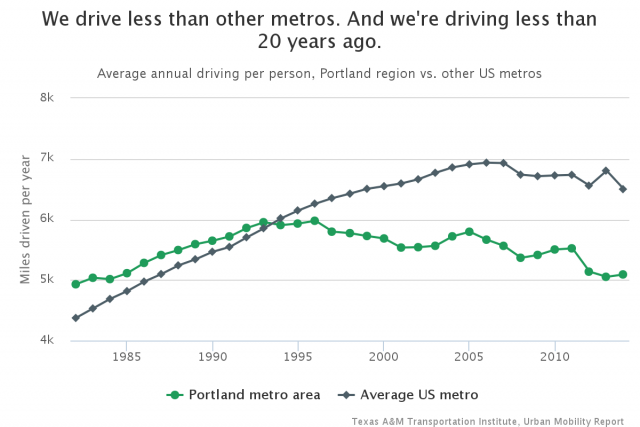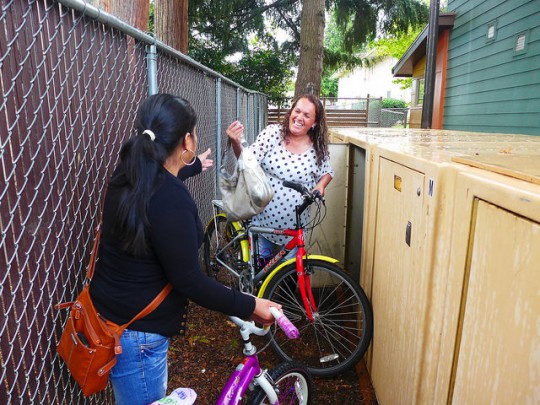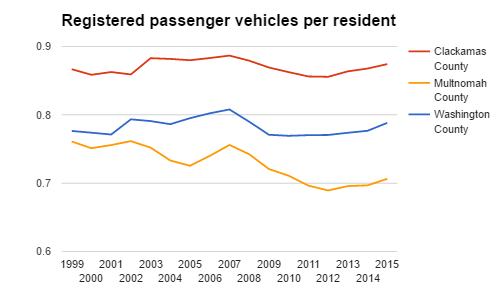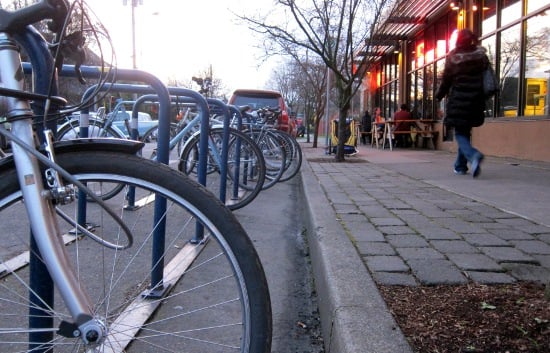(Photos: J.Maus/BikePortland unless noted)
Last month, we wrote about the 38,501 additional cars and trucks that would be in Multnomah County right now if its residents still owned cars at the rate they did in 2007.
What does it cost to own 38,501 cars? Or more to the point, what does it not cost to not own them?
For that post, we focused on the amount of space those nonexistent cars would take up. They’d fill a parking lot almost exactly the size of the central business district, for example.
But what about the money that isn’t being spent to move, maintain, insure and replace all those cars, and can therefore be spent on other things? How much money have Portlanders collectively saved by having a city where car ownership (or ownership of one car for each adult) feels less mandatory than it used to?
Because we already tackled parking space to some extent, let’s not even try to estimate its costs, even though occupying the most precious real estate in the state (maybe you’ve noticed that space has been getting more expensive?) is one of the biggest social costs of car ownership in Portland. For simplicity’s sake, let’s focus entirely in this post on the cost of owning and operating the cars that never showed up.
As we wrote last month, Multnomah County auto registrations per resident are down 7 percent since 2007, a rate that has barely rebounded despite a strong local economy that’s seen rising real wages, even though the rates in neighboring Washington and Clackamas counties are pretty much back to their long-term averages.
What’s more (as a couple people pointed out in the comments to the previous piece) as of 2014 Portland-area residents are also driving about 8 percent less than they did in 2007, even though other Americans aren’t:

So what does it cost to own 38,501 cars?
Or more to the point, what does it not cost to not own them?
The widely cited American Auto Association cost estimate for car ownership is $8,558 in 2016 for an “average” sedan driven 15,000 miles per year. That figure doesn’t include parking (the cost of owning a property with a driveway or garage, for example) or the health costs of spending too much time in a car. But on direct costs it’s inflated, because it assumes you buy a new car every five years, buy top-quality insurance, drive it through five typical U.S. winters, and then trade it in. Most Americans don’t buy new cars constantly or top-quality insurance. And Portland winters don’t kill cars that fast.
So to be conservative, let’s cut AAA’s insurance cost estimate by 25 percent, to $917 per year. And let’s reduce its depreciation and financing by 75 percent, to just $1,111 per year. (This assumes that if you saved $93 every month, you could afford to buy a car with cash by the time the old one died.) And because auto registration fees in Oregon are very low and there’s no sales tax, let’s estimate $150 a year for registration, title fees and emission inspections rather than AAA’s $683 average.
That comes to:
$917 for insurance
+
$1,111 for purchase
+
$150 for taxes and fees
=
$2,178 for a very low estimate of direct car ownership costs per year
So just by not owning 38,501 cars that they would have owned in 2007, Multnomah County residents are saving $83,855,178 each year to spend on other things instead.
Next, we need to figure how much Multnomah County residents are saving by driving less. That’s easier. We’ll use AAA’s figures for gasoline (8.45 cents per mile), maintenance (5.28 cents) and tires (1 cent). So 14.7 cents per mile.
According to figures compiled by Metro, the average Portland-area resident drove 472 miles less in 2014 than in 2007. So that’s another $69 annual savings per person, or $53,945,366 for everybody in Multnomah County.
So Multnomah County’s transportation savings from reduced car ownership comes out to:
$83,855,178 that we’re saving by not owning cars at 2007 rates
+
$453,943,366 that we’re saving by not driving cars at 2007 rates
=
$137,800,544 every year that we can spend on other things
Breaking news: $138 million per year is quite a bit of money.
For example, it’s enough:
To buy every Multnomah County resident a new $700 bicycle every four years. ($138 million a year.)
Or to cover the annual wages and benefits, including vacation and overtime, for every TriMet bus driver. ($123 million a year.)
Or to very nearly eliminate TriMet fares. ($139 million a year)
Or to have built the city’s entire Bike Plan for 2030 (“Can the city afford it?”, the Oregonian’s front page asked in 2010) … by last summer. ($613 million)
Or to eliminate tuition at Portland Community College. ($103 million a year.)
Or to sextuple the size of this November’s affordable housing ballot measure, paying for about 6,000 new price-controlled public housing units rather than the 1,000 currently planned. ($115 million.)

(Photo: Jaclyn Hoy for CCC)
Or to offer every Multnomah County resident one free pint of beer every Tuesday at the Lompoc 5th Quadrant, including tip. ($138 million a year.)
It’s not this simple, of course. The ways Portlanders are getting around instead of driving have some costs, too — a few more bus drivers in rush hour; the couple dozen new bike shops that have opened since 2007; thousands of bicycles; probably a few more burritos consumed per capita as more of us fuel our own movements.
This shift has already happened with hardly anyone noticing. And that’s sort of the point.
And the money being saved here can’t simply be moved from one use to another. The many thousands of families who enjoyed this savings have already spent it on other things they want … including the various tax hikes they may have voted for recently to improve local parks, schools and so on.
In other words, this shift has already happened with hardly anyone noticing. And that’s sort of the point. Not only has 7 percent of per-capita car ownership and 8 percent of per-capita driving been eliminated from the economy without overall ill effects — the local economy has been booming, with Multnomah County leading the pack.
Certainly the local economic boom is happening for many reasons. But it can’t hurt that in the last 10 years, we’ve successfully built a county whose residents don’t have to spend $138 million every year to move around inside well-crafted pieces of gradually disintegrating metal.
Imagine what other things we could do if we can keep chipping away at the $2 billion that we’re still spending on that.
— Michael Andersen, (503) 333-7824 – michael@bikeportland.org
Our work is supported by subscribers. Please become one today.
The post Portland’s drop in car use frees up $138 million in our local economy every year appeared first on BikePortland.org.
from Front Page – BikePortland.org http://ift.tt/2aexyb4



No comments:
Post a Comment